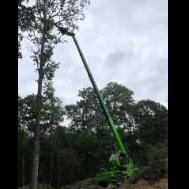Hi guys
For heave to occur there must be a persistant soil moisture deficit (SMD), e.g the soil does not reach field capacity (ie when the soil reaches the maximum amount the pore spaces can hold before saturation point) when rehydrating in the wetter autumn/winter seasons.
If this occurs over progressive seasons then the SMD increases, thus if the tree is removed under such circumstances then heave can occur.
With an SMD present it can take up to several years for soils to rehydrate to field capacity as the mositure deficit is reduced...
As a general rule, as others have pointed out for heave to occur, the tree needs to predate the building, although this is not always the case.
Nevertheless, as stated by other members, subsidence and heave can ONLY occur on soils subject to volumatic changes e.g clay soils. The volumatic changes are subject to the plasticty index of the soil (PI) which differ depending on the amount of clay particles in the soil.
I must point out that heave happens very infrequently and is dependant on alot factors, the obvious being soil PI, foundation depths, rainfall, drainage, site history, climate patterns, soil permability etc...
If foundation depths are sufficient for the soil type then neither subsidence or heave will be an issue.
There is a perception that heave will occur when ever you remove a tree on a clay soil, this is certainly not the case!
It is also important to differentiate between direct damage e.g tree roots damaging structures through pushing against them (walls, paths etc) and indirect damage, that being causing soil volumatic changes through water uptake.
For an informative, I deal with all subsidence cases coming into my L.A and have been trained to make a decision in such matters. Please don't think i'm trying to give it the 'big un'!! but have dealt with many cases with TPO and council owned trees.
Nevertheless as other members have pointed out, it is a complex topic that has many variables and my comments are a brief over view.
One think I disagree on is not giving your professional opinion, firstly get some knowledge on subsidence issues and then you WILL be able to safely offer some advice and then before long, you can actually charge the client.
I know the old saying 'a little knowledge is a dangerous thing' but get informed and you can pass on the appropriate advice! For example it doesn't take much to realise that subsidence and heave only occur on clay soils!! The client will appreciate that straight away and that will put you above others to get the job...
I have template for subsidence investigations should anyone want to bite the bullet and explore a bit more...
Cheers Gmann





